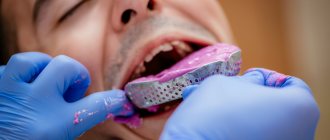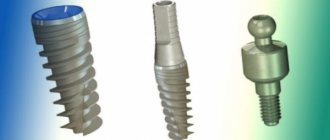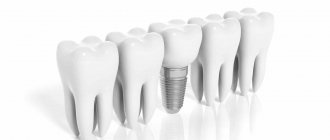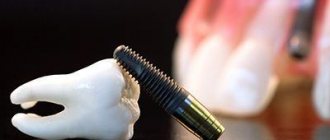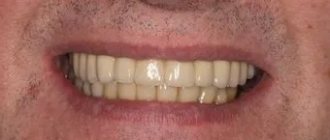Is it possible to restore teeth with implantation in one day?
A technique that allows you to quickly restore one or more missing teeth is called one-stage implantation and involves installing an implant and a temporary crown on it during just one appointment with a doctor. Moreover, the operation is performed transgingivally without making an incision in the gum and folding back its flap (dental implantation without an incision). It is worth mentioning one more technique, which is usually used in cases where a tooth destroyed as a result of injury or a long-term inflammatory process cannot be completely treated or restored with a crown or dental inlay. In such situations, which occur quite often, the tooth is removed, an implant is immediately installed in its place and it is loaded with a temporary crown, that is, a simultaneous implantation is performed.
Work results
Some of the latest results of implantation work. Click on the image to see the full before and after photos:
Result of dental implantation No. 23. Click on the image
Result of dental implantation No. 17. Click on the image
Result of dental implantation No. 9. Click on the image
Other results of work...
What are the advantages of one-stage implantation?
Firstly, with its help you can close the gap formed due to tooth loss with a reliable and aesthetic design and not be embarrassed about your smile. Secondly, a temporary dental crown immediately installed on the implant allows you to create an ideal gum contour and avoid the appearance of a very common defect during delayed implantation - black triangles - spaces between the artificial tooth and adjacent natural teeth not covered by soft tissue. And thirdly, one-stage implantation reduces treatment time by approximately half.
To attract clients, some clinics often call the one-stage method express implantation and promise to completely restore the patient’s tooth in one day. But you need to understand that during one appointment, the doctor can load the implant only with a temporary crown, and install a permanent one three to four months later. Loading an implant that is not yet fully stabilized in the bone with a fairly heavy permanent structure threatens, firstly, with its rejection, and secondly, with the occurrence of a rather dangerous defect. The fact is that after the operation the soft tissues are very inflamed and fit very tightly to the crown. After some time, the swelling subsides and a gap forms between the gum and the prosthesis, which is closed with a more suitable permanent crown. If you immediately install a permanent structure on the implant, the resulting gap will no longer be able to be closed. After some time, the gums will sink even more and expose the abutment, which will be very noticeable when you smile, and the bacteria accumulating on it will cause inflammation and, as a result, re-implantitis.
Mini implants
Mini-implants are miniature titanium pins with threads (similar to classic implants), only with a smaller diameter - from 1.8 to 2.4 mm. Most often, they are used to improve the fixation of removable dentures - in this case, the root part of the threaded mini-implants is screwed into the bone, and the part protruding above the gum serves to fix the removable denture.
Less commonly, mini-implants are used for fixed prosthetics with bridges of short length. For example, this is relevant for a narrow alveolar process of the lower jaw - if the patient is unwilling to undergo bone grafting to increase bone thickness. In orthodontics, these implants are used to create a stationary lever when moving teeth.
Important: if you are considering the option of removable prosthetics on mini-implants, then the most important thing you should pay attention to is that there are 2 systems for fixing removable dentures to mini-implants. Firstly, a fixation system using traditional ball-shaped abutments (Fig. 2-3). Secondly, the latest Locator® system, which uses equator-type abutments.
Advantages of mini implants:
- no need for bone grafting,
- low trauma and rapid tissue healing after surgery,
- fast terms of prosthetics,
- comfort – they allow you to achieve good fixation of a removable denture, as well as significantly reduce the size of its plastic base.
Below we will tell you about the features of the operation of installing mini-implants, as well as the stages of prosthetics on them with removable dentures, as well as fixed bridges. It should be noted that due to the lower cost and simpler installation, the cost of mini implants for the operation will be lower than the cost of installing classic implants.
What is better: classic two-stage implantation or one-stage implantation?
It is, of course, best to restore the front teeth using a one-stage technique, but the presence of contraindications does not always allow it to be carried out. In such cases, we resort to a two-stage technique, which is also one of the most effective methods of prosthetics. Therefore, it is impossible to call any of the above methods the best. It is important to understand which one will be most acceptable and safe for the patient. However, let us outline all the advantages of one-stage implantation:
- the ability to complete the entire procedure in a short period of time;
- use of local anesthesia only;
- the ability to carry out installation, even with complete or partial absence of teeth;
- absence of invasive and painful surgical intervention;
- the possibility of performing the procedure even with a small amount of bone tissue;
- installation of an implant immediately after tooth extraction;
- the ability to perform chewing movements on the day of the procedure;
- relatively low cost.
Preparing for surgery
The success of the operation depends on the quality of preparatory measures. A thorough examination and preparation of the oral cavity will help avoid complications after implantation.
- CT diagnostics Using 3D images, the size of bone tissue, its structure and density, and the location of anatomical structures - nerves, maxillary sinuses - are assessed. Data are needed to evaluate the possibility of immediate loading of implants with crowns or prostheses. Using diagnostic images, the implant fixation sites are determined, and a virtual treatment plan is drawn up using a computer program.
- Sanitation of the oral cavity Examination of the oral cavity, the condition of the gums, neighboring teeth for the presence of foci of infection that can lead to implant rejection (caries, dental plaque and hard deposits, inflammation of mucous tissues). If problems are detected, hygienic cleaning, treatment of teeth and gums is carried out to create sterile conditions in the oral cavity before surgery.
Hygienic cleaning and dental treatment can be carried out immediately before implantation, combining all procedures into one treatment complex during sleep. For the convenience of patients and to save time, we strive to combine all procedures into one visit .
Feature No. 4: Fast recovery period
After careful preparation for the implant installation procedure and 3D modeling of the treatment process, the doctor sets a date for the surgical stage. However, the word “surgical” in most cases does not mean complex and traumatic manipulations at all. The installation of artificial roots is mainly carried out in a minimally invasive manner, eliminating incisions, sutures, peeling of the gums, and severe bleeding. Implants are implanted into the jawbone using specially prepared stencils or surgical templates with holes. This approach allows everything to be done accurately, and the procedure can be easily transferred to patients who need to restore a large number of teeth at the same time. As a result, the implant healing process is faster, and the risk of developing peri-implantitis is minimized.
Quite a quick recovery period
Immediate loading with a prosthesis also plays an important role in rapid rehabilitation, because it is due to the rapid activation of the function of full chewing of food that the jawbone is restored and regenerated in the shortest possible time.
Installation of ROOTT implants (Switzerland) using one-stage technology
Patented ROOTT implant system made in Switzerland. The rods are presented in the form of anatomical dental roots, designed for penetration into a narrow bone and with its minimum volume.
The main feature of such roots is that they penetrate into the deepest, hardest layers of bone. Also, when using ROOTT systems, permanent dentures can be installed a week or two after screwing in the rod.
- ROOTT Compressive - screw compression rods of one-piece design. They are embedded in the basal and cancellous layers of bone, can be used with a narrow ridge, and are screwed transgingivally.
- ROOTT Basal are screw basal-cortical implants, in which the main part is screwed into the deep layers of the bone. They are used for narrow ridges or bone deficiency and are suitable for one-stage implantation.
Thanks to a simple and atraumatic installation procedure, ROOTT dental implants take root well with a minimal rehabilitation period for the patient.
All-on-4 and all-on-6 protocols
Speaking about what types of dental implantation exist, we cannot fail to mention technologies that allow you to restore the chewing functions of the jaw even in the absence of teeth.
This is an original development, in which the prosthetic structure is fixed to 4 or 6 implants, acting as supports.
If the patient has several of his teeth left, they are removed before prosthetics.
The procedure itself is carried out as follows:
- with the “all-on-4” technology, four implants with a removable abutment are implanted into the jaw: 2 - vertically in the central part of the jaw, and 2 - at an angle from 30 to 45 degrees in the lateral parts of the dentition;
- with the “all-on-6” protocol, six implants with a solid abutment are installed: 2 – vertically in the central part of the dental row, and 2 more on each side and also at an angle.
Placing the implants at an angle increases the area of contact with the bone and increases the level of fixation. In addition, installation at an angle allows the operation to be performed even with a limited amount of bone tissue without sinus lift.
Warranty
- The ROOTT implant system is lifelong.
- Conditionally removable dentures supported by implants – 12 months.
- Frame of orthopedic structures – 10 years.
The terms of the guarantee are specified in the contract; to obtain it, you must comply with its terms. The guarantee is valid if the patient:
- Does not miss scheduled visits to the doctor.
- Maintains oral hygiene recommended by the doctor and indicated in the patient’s service book.
- Undergoes professional hygiene of the oral cavity and orthopedic system.
Computer diagnostics to eliminate risks
Performed on a high-precision dental tomograph Sirona Galileos (Germany)
- Assessment of bone tissue parameters, size and density to select an implant model
- Identification of anatomically important structures (nerves, vessels, maxillary sinus) to avoid their damage
- Virtual 3D surgery planning for error-free implantation
Questions that often worry patients
How painful is the implantation procedure?
The operation to install the implant is performed under anesthesia. Painful sensations in the postoperative period are eliminated by taking non-steroidal anti-inflammatory drugs.
Can the implant fail to take root?
Implant failure is rare. In such a situation, the doctor replaces the unused implant with a new one under warranty.
What negative consequences can occur after implantation?
In rare cases, inflammation of the tissue around the implant may develop - peri-implantitis, which can be successfully treated in the early stages.
By contacting the Aurora Star clinic in St. Petersburg regarding implantation, you will receive assistance from highly qualified specialists who take into account the individual characteristics of the patient and strictly follow treatment protocols. The foresight of professionals will avoid any negative consequences. Sign up for a consultation and find out directly from the implantologist the variations in dentition restoration in your case. Perhaps the problem is solved much faster and more effectively than you think. We are waiting for you in our clinic!
Lifetime Warranty
We have eliminated the risk of errors at every stage - from 3D diagnostics, surgery planning and the use of high-tech equipment to a complex of accelerated rehabilitation. Therefore, without fear, we provide a lifetime guarantee for implantation in the Dr.Levin LifeTime Warranty format .
Operations are performed only by experienced maxillofacial surgeons and implantologists who perform complex operations every day.
We work exclusively with premium Nobel Biocare implants, for which we issue warranty certificates.
In 2004, our clinic received the status of Nobel Biocare Center of Clinical Excellence in Eastern Europe. This means that over 10 years of work, the percentage of rejection of implants installed in our Center is less than 2%.
